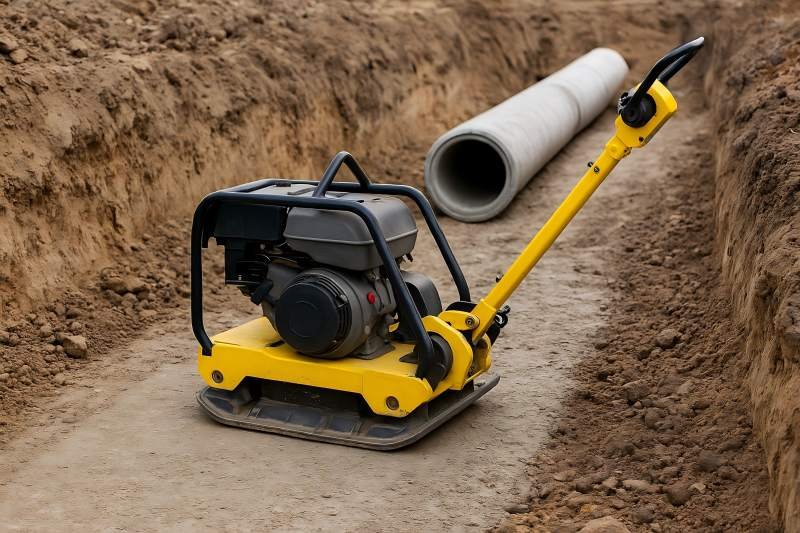When it comes to soil compaction in construction and landscaping projects, choosing the right equipment can significantly affect the quality of your work. Two common tools used for this purpose are the hand tamper and the vibrating compactor. While both serve the same fundamental purpose of compacting soil, they have distinct characteristics and applications. Here are nine key differences between a hand tamper and a vibrating compactor.
1. Design and Construction
Hand Tamper
A hand tamper, also known as a manual tamper, hand tamper, typically consists of a heavy flat base attached to a long handle. The user manually lifts and drops the tamper onto the ground to compact the soil. The simple design makes it easy to use in confined spaces.
Vibrating Compactor
In contrast, a vibrating compactor features a flat plate that vibrates to compact the soil. It is powered by a motor, which generates vibrations that help densify the material. The design allows for more efficient operation over larger areas compared to a hand tamper.
2. Method of Operation
Hand Tamper
The operation of a hand tamper is straightforward and requires physical effort. The user manually lifts the tamper and strikes the ground repeatedly, applying force to compact the soil. This method can be labor-intensive and time-consuming, especially for larger areas.
Vibrating Compactor
A vibrating compactor operates with minimal physical effort from the user. The machine’s motor produces vibrations, which penetrate the soil, allowing for effective compaction without requiring the operator to exert much force. This method is faster and more efficient for larger projects.
3. Compaction Force
Hand Tamper
The compaction force generated by a hand tamper is primarily dependent on the weight of the tamper and the user’s strength. While it can effectively compact soil in small areas, the force may not be sufficient for denser materials or larger surfaces.
Vibrating Compactor
Vibrating compactors provide a higher compaction force due to the combination of weight and vibration. This allows them to compact various materials, including granular soils and asphalt, more effectively than a hand tamper. The vibrations help to eliminate air pockets, achieving denser packing.
4. Efficiency and Speed
Hand Tamper
Using a hand tamper can be slow, particularly for larger areas. The manual lifting and striking process takes time, making it less efficient for extensive compaction tasks. It’s best suited for small projects or areas that are difficult to access with machinery.
Vibrating Compactor
Vibrating compactors are designed for speed and efficiency. They can cover larger areas in a shorter amount of time, making them ideal for significant projects. The ability to compact rapidly without manual labor contributes to faster project completion.
5. Versatility
Hand Tamper
Hand tampers excel in confined spaces and tight corners where larger machinery cannot reach. They are ideal for compacting around foundations, fence posts, or other structures where precision is required. However, their versatility is limited to smaller tasks.
Vibrating Compactor
Vibrating compactors are versatile and can be used for a wide range of applications, including compacting soil, gravel, and asphalt. They are effective in both large and medium-sized areas, making them suitable for various construction and landscaping projects.
6. Operator Skill Level
Hand Tamper
Using a hand tamper requires minimal training, as the operation is straightforward. However, achieving consistent results can depend on the operator’s strength and technique, which can vary among users.
Vibrating Compactor
While vibrating compactors are generally user-friendly, they may require some training to operate effectively, especially for those unfamiliar with heavy machinery. Understanding the controls and safety features is essential for safe and efficient use.
7. Maintenance Requirements
Hand Tamper
Hand tampers are low-maintenance tools. They require minimal upkeep, usually just a cleaning after use to remove dirt and debris. Since they have no moving parts, they are less prone to mechanical failures.
Vibrating Compactor
Vibrating compactors require regular maintenance to ensure optimal performance. This includes checking engine oil, air filters, and other mechanical components. Proper maintenance is crucial for extending the life of the machine and ensuring safety during operation.
8. Cost
Hand Tamper
Hand tampers are generally more affordable than vibrating compactors. Their simple design and lack of machinery make them a cost-effective choice for small projects or occasional use.
Vibrating Compactor
Vibrating compactors tend to be a more significant investment due to their complexity and efficiency. While they may have a higher upfront cost, their ability to speed up work and handle larger tasks can lead to savings in labor and time.
9. Ideal Use Cases
Hand Tamper
Hand tampers are best used for small areas, such as:
- Compacting soil around fence posts
- Filling trenches or narrow spaces
- Small landscaping projects
Vibrating Compactor
Vibrating compactors are ideal for larger projects, including:
- Building foundations
- Paving roads or driveways
- Compacting gravel for patios
Conclusion
Choosing between a hand tamper and a vibrating compactor ultimately depends on your specific project needs. While hand tampers are simple, cost-effective tools suitable for small areas, vibrating compactors offer efficiency and versatility for larger tasks. Understanding the key differences between these two tools will help you make an informed decision, ensuring you select the right equipment for your soil compaction needs.



